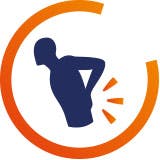What are the best pain treatments for you?
Finding effective pain treatments can feel like an urgent mission when you’re experiencing pain. While we love taking a glass-half-full approach to life, looking on the bright side of pain is not always easy. Nor is it always beneficial. Often, pain serves a purpose. For example, did you know that inflammation is the body’s natural, protective response to an injury? While it can feel unpleasant it’s your body increasing blood flow to the area to help healing. Ignoring pain can have negative consequences in the long-term, not to mention the short-term impact on how your day/week/month is going. Figuring out the best pain treatments for your pain type can be challenging. We’re here to help.
We understand that finding an effective pain treatment means so much more than just being pain free. It can mean not giving up on cooking a holiday meal for loved ones or gossiping with a friend on a walk around the block. It can mean living your life joyfully, without having to give up on the things you love. That’s why we’re here to help you make sense of what pain is and help you manage it.
What is pain?
Let’s dive in. Pain is an important part of how our bodies function. It can let us know that something isn’t quite right.1 In doing so, body pain alerts us to protect ourselves from further harm by prompting us to stop what we’re doing, take stock, and avoid repeated injury or permanent damage to our bodies. Pain is what can keep us from making our situations worse than they need to be.
Pain is controlled by the nervous system and is a very complex process. It occurs when a stimulus, like a fall, or overexertion of a muscle, triggers receptor nerve cells to send messages through your spinal cord to your brain. These receptors can sense heat, cold, light, touch, pressure -- and pain! Pain is always subjective. So, each of us experiences pain in our own way. Depending on its severity, as well as your body’s very own unique way of processing it, pain can bring about other physical symptoms, like nausea, dizziness and weakness.

Pain can be categorized of two types, acute or chronic, i.e., long-term. In the long-term situation, it’s not a case of ‘no pain no gain’ -- toughing it out isn’t necessarily the best course of action. See your doctor if the pain you are experiencing is chronic or not because of a recent injury.
Being in pain can have quite an emotional impact. Pain can affect how you go about your daily life, keeping you away from activities you once enjoyed. It can also hamper your quality of sleep. Being sleep deprived has ties to poor short- and long-term health markers and decreased mental well-being.
What is Acute pain and how does it differ from long-term pain?
| Acute pain* | Chronic pain |
Short-lived² |
Long-lasting (more than 3 months) |
Usually the result of an injury |
Usually the result of an underlying condition or long-term illness |
Examples of acute pain causes: sprains, strains or sports injuries (e.g. ankle sprain, shoulder strain or back muscle pain) |
Causes: Underlying diseases or conditions |
Responds well to pain treatments |
Can be resistant to some pain treatments |
*Voltaren is for relief of pain associated with recent (acute), localized muscle or joint injury.
Causes by pain type and managing pain
Body pain can have a myriad of causes. Understanding the type and cause of your pain will help you identify the best ways to manage your pain.
Pain can be focused on a specific location on your body. Each of these requires slightly different care and treatment, sometimes merely due to how we tend to move and use our bodies. While Voltaren is used for the relief of recent pain associated with muscle or joint injuries, here are some of the most common pain locations:

- Back pain - Back pain is a common cause of body pain with many causes including heavy lifting. Affecting some of the largest muscles in your body, back pain can have a big impact on how you move about your day. Common causes include accidents, sports injuries, lifting incorrectly or sitting or driving for long periods without taking a break. Find out more here.

- Shoulder pain – There are many potential causes of shoulder pain. But whether it’s a sports injury or sleeping on it funny, our shoulders are prone to strains and sprains. Shoulder pain can take the flourish out of daily movements. Find out more here.

- Ankle pain - Our ankles get a lot of use day in and day out that can cause injuries such as tendonitis and joint inflammation. That's why ankle pain is no walk in the park. Find out more here.

Managing your pain is key to living life joyfully and to the fullest. This can include both medicated and non-medicated alternatives, or even a combination of the two. Here are some straightforward pain management techniques that are easy to incorporate into your repertoire:
- Stretching
- Therapeutic massage
- Light exercise
- Mindfulness meditation
- Cold and heat
- Biofeedback3
Always talk to your doctor before trying any new pain management techniques to see if they are right for you.





